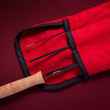About one hour ago, I mixed three tablespoons of Miralax with eight ounces of Gatorade and downed the concoction like a college sophomore knocking back a Jägerbomb at an SEC tailgater. Then I set my iPhone’s timer for fifteen minutes. Since, I’ve mixed, rinsed, and repeated every time the three-chord mandolin riff blasts from my phone. I’ll continue playing this game until I’m no longer full of the stuff my friends say fills me, which will ensure the gastroenterologist can take clear pictures tomorrow morning when I arrive and wait one, two, or possibly three hours for my scheduled photo shoot.
Everything’s been a numbers game lately. Two days ago, my physician’s nurse called to say my latest blood test puts my ten-year risk for heart disease three and a half percentage points higher than they’d like it to be, so I should eat baked chips—the ones with two-thirds the saturated fat of the fried ones—or, better yet, I should eat none at all and replace them with carrots, cucumbers, and celery. When she showed me the formula for converting my HDL, LDL, and lipid numbers into her ten-year risk percentage, I used a version of Lou Costello’s classic “seven times thirteen is twenty-eight” skit to make my case for Kettle sea salt and vinegar chips. Having grown up over three decades after me, she had no idea what I was doing. “Just buy some veggies, please,” she said.
This Saturday is the last in April—the day the State of Michigan opens its Type One and Type Two streams to trout fishing for one-hundred fifty-seven consecutive days. If I want to please my wife with a brook-trout meal and prove I spent the day fishing instead of whatever it is she imagines me doing when I say I’m fishing, I’ll need to hold my hand in the shape of the “hang loose” gesture and measure the fish against the width from the tip of my thumb to the tip of my pinky.
For my hand, that distance is a little over eight inches—or one more than the seven the trout will need to span. We can fry Roxanne’s in bacon grease, but on doctor’s orders, mine will have to sizzle in extra virgin olive oil, which—the doc says—enables those omega-3 fatty acids in the brook trout’s tasty flesh to chip away at my risk factors.
With the season’s opening, anglers who struggled to subtract line 24 from line 33 on their 1040 form just a few weeks ago will surprisingly channel their inner Pythagoras and become wizards in a relatively modern branch of mathematics called angleratorics. In this branch, each inch of a trout’s length translates to a new unit called the ench. Similar to the way degrees in Celcius convert to Fahrenheit, inches convert to enches by the formula:
ench = inch x 1.2 + 2
If, for example, an angler catches an eight-inch brook trout, this formula expands the fish to eleven-point-six enches, which they’ll round to twelve.
“How’d you do today?”
More Like This
“Great. I caught a bunch of twelve-ench brookies,” they say, using the associative property of angleratorics to equate the numbers one and two with a bunch.
You can use the formula in reverse, too:
inch = (ench - 2)/1.2
So, when a friend says they ripped streamers all day and busted a twenty-encher on a yellow double-crack donkey stacker, you can subtract two, divide by one-point-two, and see the fish as the fifteen-incher it was.
As the season progresses, we anglers adapt our tools to the conditions. Sometimes, we’ll pack three- or four-weight rods into remote blue-line streams. Other times, we’ll use five- or six-weight outfits to chase eighteen- to twenty-ench trout on full-grown rivers. When we’re after bass, we might gear up with seven- or sometimes eight-weight sticks, and when we lose our sensibilities, we’ll pull out the ten-, eleven-, or even twelve-weight poles for monster pike and the toothy unicorns known as musky. Most of us have a qualitative feel for what these numbers mean. But for newcomers, it can be utterly confusing.
“What’s the difference between a three-weight and a five-weight fly rod?” an apprentice asks.
“Well, a three-weight rod is built to cast a three-weight line, and a five-weight rod is built to cast a five-weight line,” we tell them, charitably omitting the “duh” after the opening “well.”
“Yeah, I got that. But what’s the difference between a three-weight line and a five-weight line?” the apprentice asks, their voice revealing a hint of agitation.
“A five-weight line is thicker and heavier than a three-weight line,” we respond, seriously considering inserting an uncharitable “duh” this time.
“Yeah, I got that, too. But how much heavier?”
“Well, the first thirty feet minus the level tip for a three-weight line should have a nominal weight of one hundred grains, where about fifteen and a half grains make up one gram. For a five-weight line, the nominal weight should be about one-hundred forty grains,” says no fly angler I’ve ever known.
As an alternative, we could tell the apprentice the mass of the fly line is roughly an exponential function of the integer numbers we use to classify them, especially in the range from four to twelve, where jumping up one number increases the mass of the first thirty feet of the line by about fifteen percent. But most of us develop an intuitive relationship with rod and line weights. We cast a ten-weight rod instead of a six-weight in the same instinctual way a carpenter hammers a ten-penny nail instead of a six. Why? Because.
Little in fly fishing is immune from the numbers game. The leaders we attach to our fly lines, especially the ones for trout, use numbers to specify their lengths and terminal diameters. The most common lengths are seven and a half and nine feet, and the typical terminal—or tippet—diameters are 3X, 4X, 5X, and 6X. Most of us don’t need a crib sheet to figure out how long a foot is, but to determine a tippet’s diameter (in thousandths of an inch) from its ‘X’ designation, we need to use a mathematical formula:
dia = 11 - X
A 0X tippet is eleven-thousandths of an inch in diameter. A 5X is six thousandths. Pretty simple, right? But tippet diameter is like inflation in the sense we are usually more concerned about the percentage change than the absolute change. Moving from 0X to 1X, 1X to 2X, 2X to 3X, or 3X to 4X decreases the diameter by roughly ten percent. But going from 4X to 5X, 5X to 6X, or 6X to 7X reduces the diameter by fifteen to twenty percent. That means the percentage change from 4X to 5X is more significant than from 3X to 4X. To keep these changes more similar, some manufacturers offer 4.5X, 5.5X, and 6.5X—not only to entice us to buy more stuff—but to maintain that every transition to the next finer tippet reduces the diameter by about ten percent. It’s not the size of the change that matters but rather the rate at which it unfolds.
It’s the longest day of the year. Birds sing, flies hatch, and fish rise all around you. But they ignore your casts, even the good ones. You know you have the right pattern—well, you know that as well as you can ever know something like this—and conventional wisdom says you should go down one size with your fly. So, you bring in your line, cut the number sixteen fly from the tippet, and replace it with an eighteen. Yes, going down one size means increasing the number by two. But how much smaller is your hook? Hook size seems to be the most imprecise number in fly fishing. As a rule of thumb, you can say that each increase by two—such as ten to twelve or twelve to fourteen—will decrease the hook’s gape by fifteen percent, but you won’t find a formula to confirm or deny this rule. While conforming to a loose standard, most hook manufacturers resist quantifying their hook sizes. Creative privilege appears to be the number one rule of the game.
U2, Metallica, Ed Sheeran, and Harry Nilsson have all praised the number One in song. And in what is arguably the most celebrated sentence in fly-fishing literature, Norman Maclean declared one the most poetic number in this sport. But after forcing down my seventh Mirilax shot, this story must end abruptly with a respectfully irreverent adaptation of Maclean’s iconic observation: Eventually, all things merge into two, and a river runs through it.































Comments
John Lucid replied on Permalink
But it's all worth it: think of that oh so restful Propofol induced nap!
Anonymous replied on Permalink
Best article since Borge’s inflationary language
Pages